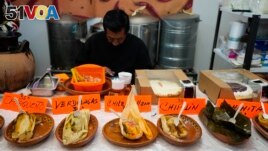01 February 2023
At least three times a week, Mexico City bus driver Nicolás Cuatencos purchases a kind of tamale known as "guajolota," or "turkey."
The food is made of corn dough and filled with meat, bean and cheese. Tamales are then wrapped in corn husks, the green leaves outside an ear of corn, or banana leaves for cooking.
Cuatencos has loved the dish since childhood. "The flavor, the dough, all of that is really good," a smiling Cuatencos said recently.

Tamales of different styles are displayed on a table during the tamales fair at the Ixtapalapa neighborhood of Mexico City, Friday, Jan. 27, 2023. (AP Photo/Fernando Llano)
But tamales are not only tasty and a good way to fuel the workday. They also carry lovely memories for millions of people like Cuatencos. He remembers his grandmother preparing tamales for family celebrations and religious events like Candlemas Day on February 2.
Connection to tradition
Tamale buying on February 2 has a connection to an earlier holiday. Mexican tradition holds that the tamale buyer on February 2nd is the person who finds the baby Jesus figure in the Rosca de Reyes cake that is eaten on Three Kings Day on January 6.
Tamales date to pre-Hispanic times. Ancient civilizations such as Olmecs, Mexicas and Mayas prepared them for religious offerings and even placed them in special burial areas.
Tamales are eaten in several neighboring countries under other names like "humita," "pamonhas," "hallaca" and "guanime." But the number of tamales in Mexico is unmatched, said chef and food researcher Ricardo Muñoz Zurita. He has identified 25 families of tamales in Mexico, which themselves have many different kinds based on ingredients, wrappings and size.
The tradition comes from a time when farmers would bring their ears of corn to the church for blessings. That would bring good luck for future crop plantings.
"The popularity of the tamal is so great that I don't think they're going to stop making them in this century because it is not an isolated dish, there is a total tamal culture," Muñoz Zurita said.
Just like his parents and grandparents did, Cuatencos said he will gather with his wife, children and other relatives on Thursday to celebrate Candlemas.
"My kids found the figurine in the cake, but I will bring the tamales," he said, adding that it is his way of passing the tradition on to his children. "Tamales are going to survive many generations because they are passed from generation to generation."
I'm Ashley Thompson.
Fabiola Sanchez reported on this story for the Associated Press. John Russell adapted it for VOA Learning English.
_
Words in This Story
dough – n. a mixture of flour, water, and other ingredients that is baked to make bread, cookies, etc.
wrap – v. to cover (something) by winding or folding a piece of material around it
flavor – n. the quality of something that you can taste
ingredient -- n. one of the things that are used to make a food, product, etc.
isolated -- adj. separate from others; happening in different places and at different times
figurine – n. a small figure or model of a person made of wood, plastic, etc.












